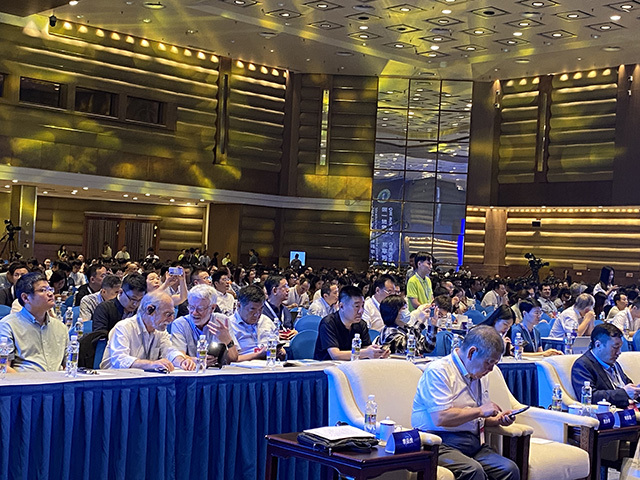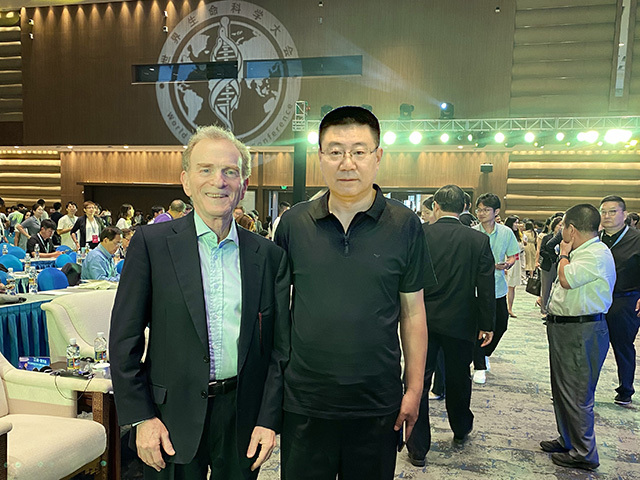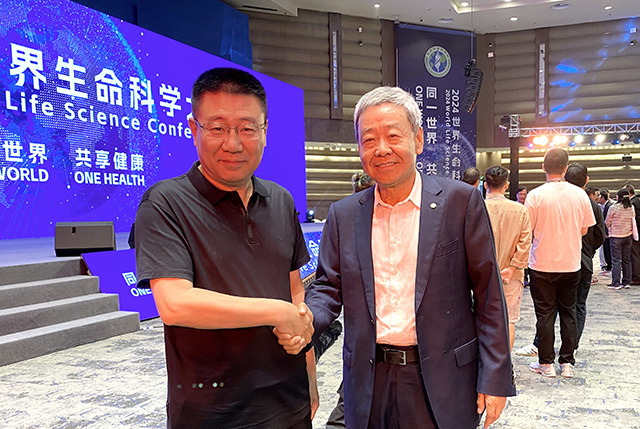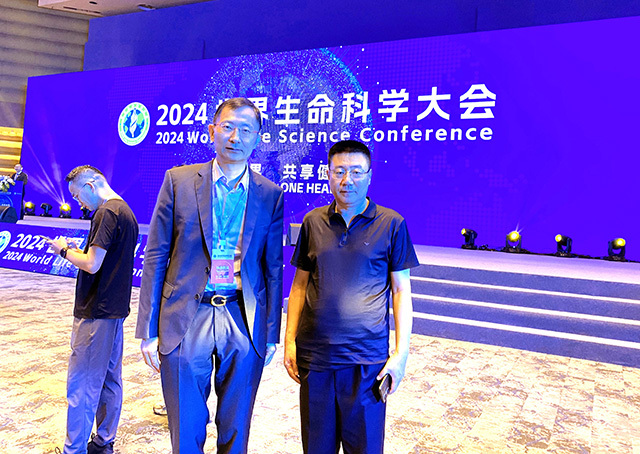Sun Zuodong Attends the 2024 World Congress on Life Sciences Potassium Channel 'Origami Windmill Model' Expands Human Cognitive Boundaries
發(fā)布時(shí)間:
2024-10-24
Brain Science Network (written by Wang Aili) The 2024 World Life Science Conference was held from October 19th to 21st at the Boao International Conference Center in Qionghai, Hainan. Researcher Sun Zuodong, President of the Heilongjiang Asia Europe Brain Science Research Institute, attended the entire conference.

The 2024 World Congress on Life Sciences is the highest level, widest coverage, and most influential academic event in the field of international life sciences. The theme of this conference is "One World, One Health". Over 60 Chinese and foreign academicians, including four Nobel laureates Randy Schekman, Barry J. Marshall, Erwin Neher, and George Fitzgerald Smoot III, attended and gave presentations for academic exchange. The Chinese chairman of the conference: Wu Weihua (Vice Chairman of the National People's Congress, academician of the CAS Member), and the foreign chairman Randy W. Schekman (winner of the 2013 Nobel Prize in Physiology or Medicine).

*Randy Wayne Schekman is an American cell biologist and professor at the University of California, Berkeley. He served as the editor in chief of the Proceedings of the National Academy of Sciences and was elected a member of the National Academy of Sciences in 1992. In 2002, he won the Lasker Prize in Basic Medicine with James Rothman for his research on cell membrane transport. In 2013, he was awarded the Nobel Prize in Physiology or Medicine.
The conference included four academic papers by researcher Sun Zuodong, among which the potassium channel origami windmill model was proposed based on the experimental results of Nobel laureate MacKinnon, which reasonably revealed the principles of "opening" and "closing" of potassium channel pores, and abandoned the selective filter atomic model and propeller model; Based on the origami windmill model of potassium channels, the phenomenon of cellular bioelectricity has been reinterpreted, and the conservation law of cell bioelectric membrane area and the equation of ion inequality have been proposed, opening up a new method and approach for scientifically quantifying the description of cellular action potential; Discovered and proved that neurons can generate electromagnetic waves, overturning the traditional view of "electricity → chemistry → electricity" transmission of information between neurons, and believing that the essence of consciousness or soul should be electromagnetic waves.

During the conference, Researcher Sun Zuodong had in-depth exchanges and learning with well-known experts and scholars at home and abroad, sharing the most cutting-edge theoretical viewpoints and advanced application methods, especially his potassium channel origami windmill model and related theories based on the potassium channel origami windmill model, which attracted high attention from the attending peers. During the exchange, the attending experts evaluated Sun Zuodong's academic achievements as "opening up new territories for life scientists" and "the origami windmill model and its related theories have the potential to be included in basic biology textbooks around the world". Professor Salama Abdelhady from Aswan University in Egypt commented online on Sun Zuodong: 'I greatly appreciate your amazing paper titled' Neurons can generate electromagnetic waves', and you have successfully demonstrated the truth of this viewpoint through a successful method. 'He expressed his willingness to collaborate deeply with Sun Zuodong. Experts attending the meeting believe that what is commonly referred to as brainwaves is not electromagnetic waves. Electroencephalography, electroencephalography, artificial intelligence (AI), brain computer interfaces, etc., have not yet truly touched upon the mysteries of the brain. Scientific exploration has no forbidden zone. From the perspective of human historical development, the main goal of brain research is not only to understand and treat various brain diseases, although this is important, but also to grasp the true essence of the human soul. The brain is a huge gold mine, and solving the mysteries of the brain is too important. It should be a joint operation of "multiple branches of arms", not just the responsibility of neuroscientists, nor can it be without the participation of physicists, chemists, mathematicians, and psychologists.

*Rao Zihe, a molecular biophysicist and structural biologist, an academician of the CAS Member, the American Academy of Arts and Sciences, and the Third World Academy of Sciences, a professor of the School of Medicine of Tsinghua University, a distinguished professor of Shanghai University of Science and Technology, a researcher and doctoral supervisor of the Institute of Biophysics of the Chinese Academy of Sciences, and a leader of the innovative research group of the State Key Laboratory of Biomacromolecules.
Experts also believe that the current development status of neuroscience lacks core theoretical support and cannot form a main academic thought and technical system. What is lacking are some new hypotheses that are astonishingly similar to the development of physics and chemistry. Newton's three major laws laid the foundation of classical physics; the birth of Avogadro's molecular theory reversed the chaotic situation in the chemical field at that time. Currently, the field of life sciences lacks its own Newton and Avogadro. The proposal of Sun Zuodong's potassium channel origami windmill model is revolutionary and of great scientific significance, providing new perspectives and tools for the basic theoretical research of life sciences. It also expands the cognitive boundaries of human beings.

*Gao Huajian, a solid mechanics scientist, is a member of the National Academy of Engineering, the American Academy of Sciences, the American Academy of Humanities and Sciences, the German Academy of Sciences, the Chinese Academy of Sciences, the Royal Society of Britain, and the European Academy of Sciences; Current Chair Professor at Tsinghua University and Dean of the Institute of Mechanics and Engineering at Tsinghua University.
At this conference, the main viewpoints of the four academic papers exchanged by researcher Sun Zuodong challenged the work of at least five Nobel laureates - Alan Lloyd Hodgkin, Andrew Fielding Huxley, Roderick MacKinnon, Bernard Katz, and Jens Christian Skou.
News Link 1: Introduction to Sun Zuodong
Sun Zuodong, born in 1966, is a researcher and postdoctoral cooperative supervisor. He enjoys special government allowances from the State Council and is a national level candidate for the "New Century Hundred, Thousand, Thousand Talents Project". He is also a recipient of the "China Youth May Fourth Medal"; Leader of the "Biomedical Electronics" Leading Talent Team in Heilongjiang Province, and Head of the Engineering Technology Research Center for Brain Disease Rehabilitation Treatment Equipment in Heilongjiang Province; Founder of Aobo Medical and President of the Asia Europe Brain Science Research Institute in Heilongjiang Province.
He is the author of the π Project in neuroscience and proposed the "The theory of brain cell activation", "The Theory of Dove-like Particles", "Potassium channel Origami windmill Model", "Conservation Law of Cell Bioelectricity Membrane Area and Ion Inequality Equation". He is the world's first inventor of Parkinson's Disease (PD) treatment device, Alzheimer's Disease (AD) treatment device, brain function rehabilitation treatment device, and depression treatment device. He is also the first person internationally to apply non-invasive brain computer interface transcranial electrical stimulation technology to the treatment of major brain diseases. Since 1994, Sun Zuodong has been focusing on physical therapy methods and theoretical research for neurological disorders for 30 years. His series of neuroscience research achievements have gone through a process of practice to theory, and then practice to theory, from the causes and mechanisms of major brain diseases to treatment methods and mechanisms, and have now formed their own system.
News link 2: Potassium Channel "Origami Windmill" Model
The "origami windmill" model of potassium ion channels is an application of physical biology principles to reveal the operating mechanism of potassium ion channels. It was created by researcher Sun Zuodong, principle: potassium ions, etc cations and within the channel helix amino acid residues with positive charges , the repulsive force formed drives the "wind teeth" to retreat and the "windmill" to rotate, the size of the potassium ion channel aperture varies with the speed of the "windmill" rotation, determining the "opening" and "closing" of the channel aperture relative to potassium ions. The characteristic is that four channels spiral to form an independent functional unit, rotating synchronously in one direction, either clockwise or counterclockwise. However, a channel "windmill" can only rotate in one direction, and the transport of potassium ions is passive and one-way, with no dependence on ATP.
Based on the potassium channel "origami windmill" model, the phenomenon of cellular bioelectricity has been reinterpreted, opening up a new method and approach for scientifically quantifying the description of cellular action potentials. It has been discovered and proven that neurons can generate electromagnetic waves, which has touched upon fundamental issues in life science and laid a theoretical foundation for humans to ultimately unravel the mysteries of the brain and reveal the essence of consciousness or soul.
哈爾濱奧博醫(yī)療器械有限公司
地址:黑龍江省哈爾濱市南崗區(qū)馬端街39號(hào)
官方客服電話(huà):400-600-4017
行政綜合辦公室:0451-82353728
臨床事業(yè)部:0451-82289506 / 82269160(傳真)

奧博醫(yī)療

腦康復(fù)之家

腦科學(xué)網(wǎng)
Copyright © 2023 哈爾濱奧博醫(yī)療器械有限公司 中企動(dòng)力 | SEO標(biāo)簽 營(yíng)業(yè)執(zhí)照 醫(yī)療器械生產(chǎn)許可證 互聯(lián)網(wǎng)藥品信息服務(wù)資格證書(shū) (黑)-非經(jīng)營(yíng)性-2016-0017


